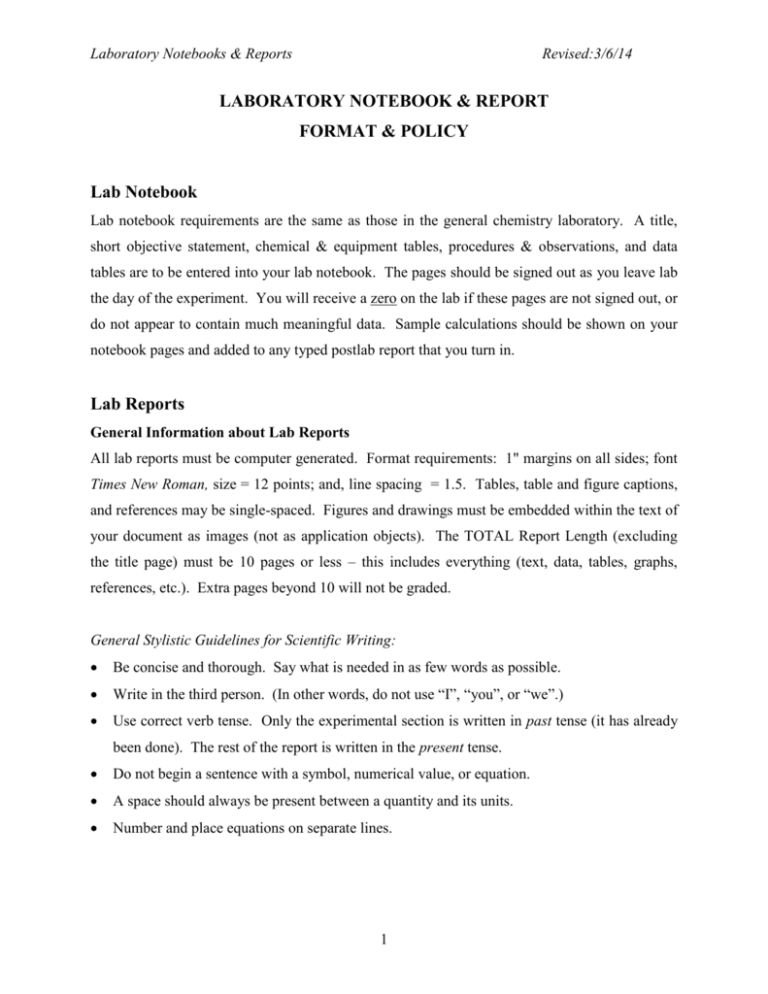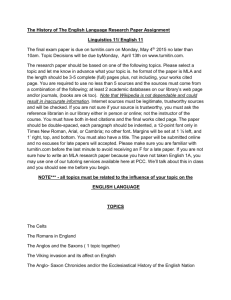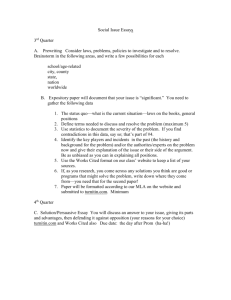Lab Reports - Unicorn Web Site
advertisement

Laboratory Notebooks & Reports Revised:3/6/14 LABORATORY NOTEBOOK & REPORT FORMAT & POLICY Lab Notebook Lab notebook requirements are the same as those in the general chemistry laboratory. A title, short objective statement, chemical & equipment tables, procedures & observations, and data tables are to be entered into your lab notebook. The pages should be signed out as you leave lab the day of the experiment. You will receive a zero on the lab if these pages are not signed out, or do not appear to contain much meaningful data. Sample calculations should be shown on your notebook pages and added to any typed postlab report that you turn in. Lab Reports General Information about Lab Reports All lab reports must be computer generated. Format requirements: 1" margins on all sides; font Times New Roman, size = 12 points; and, line spacing = 1.5. Tables, table and figure captions, and references may be single-spaced. Figures and drawings must be embedded within the text of your document as images (not as application objects). The TOTAL Report Length (excluding the title page) must be 10 pages or less – this includes everything (text, data, tables, graphs, references, etc.). Extra pages beyond 10 will not be graded. General Stylistic Guidelines for Scientific Writing: Be concise and thorough. Say what is needed in as few words as possible. Write in the third person. (In other words, do not use “I”, “you”, or “we”.) Use correct verb tense. Only the experimental section is written in past tense (it has already been done). The rest of the report is written in the present tense. Do not begin a sentence with a symbol, numerical value, or equation. A space should always be present between a quantity and its units. Number and place equations on separate lines. 1 The lab report should focus on the data and the results, not your learning process. Therefore, avoid making comments such as “The purpose of this experiment is to help us learn…” or “The goal was to learn about… “ 2 You are required to write your own report for every project, regardless of whether the project involved group or individual work. All lab reports must be typed in a word-processing application such as Microsoft Word. The Word document should be attached to your ELN and uploaded to turnitin.com. Format requirements: 1" margins on all sides; font size = 12 points; the font Times New Roman; lines spacing = 1.5. Tables, figure captions, table captions and references may be single-spaced. Figures and drawings must be embedded in your document as images; not as application objects. For example, if you generate a graph in Excel you should copy and paste it into your document using “Paste Special Image” command. Graphs should also be formatted correctly. The two graphs below contains the same data. The graph on the left contains a legend, descriptive graph title (note, the title does not restate the variables plotted on the x and y axes, axes are labeled with units (if appropriate), Axes tick labels are labeled and legible, and the data fills the entire graph window. The graph on the right lacks so many of these qualities, and would not earn any points. Sections A formal lab report contains the following sections: Title page, Abstract, Introduction, Experimental Section, Results, Discussion, & References. Each experiment has specific report preparation instructions (Post-lab instructions). The section(s) required for each week’s lab report will be outlined in that document. 3 Title Page 1 page A descriptive title should be followed (in order) with your name, your lab partner’s name, your TA’s name, the day and time of your lab section, the date the experiment was performed, and any unknown codes. Abstract 1 paragraph in length The abstract should state the objectives of the experiment. What is being studied? Then the key results, major points of discussion, and the main conclusions should be summarized concisely. Write the abstract last! You cannot summarize the experiment until you have written about it in detail. Never start your abstract with “The purpose of this experiment was…”. Introduction 1-2 paragraphs in length General information about the experiment should be given in this section. Provide background information about the topic being studied to put the subject matter in context. What kind of previous work has been done? Why is this subject matter important? Provide descriptions and definitions of related theory, techniques, and instrumentation. Finally, introduce what you specifically have done is the experiment. Why is this specific experiment significant? Experimental variable number of short paragraphs In the first paragraph of this section, describe the chemicals and instrumentation used. If complex experimental set-ups were used, a diagram or picture should be included. What was the source of the chemical – the stockroom or was the manufacturer’s bottle placed in lab? Who manufactured the instrument used? What model was it? In the next paragraphs, describe experimental procedures and observations together. Qualitative and quantitative data should be mixed into the text describing the actions taken in lab. For example, rework a procedure step indicating a reagent’s appearance within the step. Or, if an absorption spectrum is taken indicate its max within the sentence indicating that the spectrum was taken. Create at least one new paragraph for each procedural part in the lab manual. The paragraphs should be short and should not have a space between them. Raw numerical data collected in lab is occasionally presented in this section, however, specific raw data is typically included in results tables with related calculated values (see below). 4 Results up to 1 paragraph of text embedded with figures, tables, and equations Significant numerical results should be arranged in graphs and tables. All graphs and tables must have captions (see Figure & Table 1 below). The graph axes and table columns/rows must be appropriately labeled; units must be included in the labels. Figure 1: Figure caption goes here (below the figure). Embedded image goes above. Table 1: Table caption goes here (above the table). Table with your data goes below. Mixture Stock Concentration Absorbance (mL) (µM) measured Blank 0.00 0.00 -0.0021 A 1.00 50.00 0.0126 B 2.00 100.0 0.0250 C 3.00 150.0 0.0379 D 4.00 200.0 0.0503 5 Discussion 2-4 paragraphs in length Analyze the results. Compare the experimental and theoretical values (if available) and include a detailed analysis of uncertainties (errors). For example, if an unknown concentration is determined with a Beer’s Law plot, calculate a percent error if a theoretical concentration has been provided (or can be calculated), discuss why the y-intercept is not zero, interpret value of R2 given with the line equation created by Excel, and summarize your understanding of how the spectrometer’s functions affect the accuracy of your results. Show equations. Text should be used to highlight important results and describe how all results were obtained. What equations were used? What do the variables in the equations stand for? Equations should be numbered and each equation should be on a line of its own. Point out any patterns or relationships within the data and results. If further plots, such as overlayed spectra, elucidate these connections, include these items in this section. State the significance of the result. Connect what you have found to your statements in the introduction. Do your results shed any light on the importance of the broader subject? Conclusion Briefly summarize the experiment: describing what was done, how it was done, what results were obtained, and why it is important. This section is similar to the Abstract. References List all the information sources you used in preparation of this report. For journal articles, list the authors, title, journal name, volume, year, and pages. For books, list the title, authors, year, and publisher. For on-line sources, cite the web-link and the date you visited the website. Use only credible, peer-reviewed sources. Index all references in the order of appearance in the lab report. Example: (1) Gomez, A. L.; Lewis, T. L.; Wilkinson, S. A.; Nizkorodov, S. A., Stoichiometry of Ozonation of Environmentally Relevant Olefins in Saturated Hydrocarbon Solvents. Envir. Sci. Technol. 2008, v. 42, pp. 3582-3587. (2) AirUCI: Atmospheric Integrated Research for http://www.chem.uci.edu/airuci/, accessed on 09/21/2009. 6 Understanding Chemistry at Interfaces. (3) Finlayson-Pitts, B. J.; Pitts, J. N. Chemistry of the upper and lower atmosphere: Theory, experiments, and applications; Academic Press, San Diego, 2000, ISBN 012257060X, 969 pages. Grading Each lab report is worth 100 points (except for the final lab report which is 200 points). Specific guidelines for each report are given in the postlab instructions. Please remember that the TOTAL Report Length (excluding the title page) must be 10 pages or less – this includes everything (text, data, tables, graphs, references, etc.). Extra pages beyond 10 will not be graded. The TA will deduct points for stylistic, grammatical, and spelling mistakes in reports. Therefore, pay attention to your writing as well. Your TA will be at liberty to remove points from your report for formatting reasons. Lab report submission Upload lab reports to the ELN and turnitin.com. The deadline feature on turnitin.com automatically prevents submission of reports after the due date. o By enrolling in this course you agree that all work will be submitted for textual similarity review to Turnitin.com for the detection of plagiarism. All submitted papers will be included as source documents in the Turnitin.com reference database for the purpose of detecting plagiarism in the future. Use of the Turnitin.com service is subject to the Usage Policy agreement posted on the Turnitin.com site. o Submit the final version (identical to the printed one) of your report. If no electronic version is submitted or if significant differences are detected between the electronic and printed version you will receive a zero on the lab report. Late submissions: 25% off if the report is turned in within 48 hours. No reports will be accepted after 48 hours. Your graded lab report will be returned with corrections. Look over the corrections so you do not make the same mistakes each week. See the lab TA about how and when reports will be returned. 7 Special Grading Situations Students who miss one lab due to unforeseen circumstances, can do a make-up lab the week of the experiment. Arrangements must be made with your TA. The lowest experiment score for weeks 1-7 will be dropped, so one absence will not adversely effect your grade. (The absence, may, however, affect your ability to complete the final seawater analysis project.) Safety violations. TAs will deduct points for safety violations. Category Student is late by 15 minutes or more Minor safety violations (forgetting to put protective gloves on; taking protective goggles off frequently; setting beakers too close to the edge of the lab bench; exiting the lab while wearing protective gloves) Poor work practice (cluttered work bench area; improper handling of chemicals leading to their contamination; improper handling of lab equipment leading to potential damage; improperly disposing of chemicals; etc.) Major safety violations (e.g., refusal to adhere to the safety guidelines described above; horseplay in the lab; deliberately breaking glassware or spilling chemicals; etc.) Points removed 10 pts / ea. 15 min. up to 20 pts up to 50 pts 100 pts with possible expulsion from the course Re-grade requests. Re-grade requests will be honored only in the events of book keeping errors (i.e., the points were added incorrectly). Your lab TAs will handle all such requests themselves. Plagiarism, misconduct, collusion, etc. All reports must be written on your own. Discussions with classmates are OK, and are even encouraged. However, significant similarities in sentence structure and formatting with another student’s report or copying from the Internet sources will will get an “F”, immediate dismissal from the course, and a formal letter to the associate dean of the School of Physical Sciences with an explanation for the dismissal. 8 Content for this document derived from the following webpages: Purdue University: http://guides.lib.purdue.edu/content.php?pid=232776&sid=1940943 Kenyon College: http://chemistry.kenyon.edu/getzler/08FCourseFiles/BriefGuideWritingChemistry.pdf Germanna Community College: http://webs.wofford.edu/splawnbg/Chem_214_files/Germanna%20College%20Lab%20R eport.pdf 9




